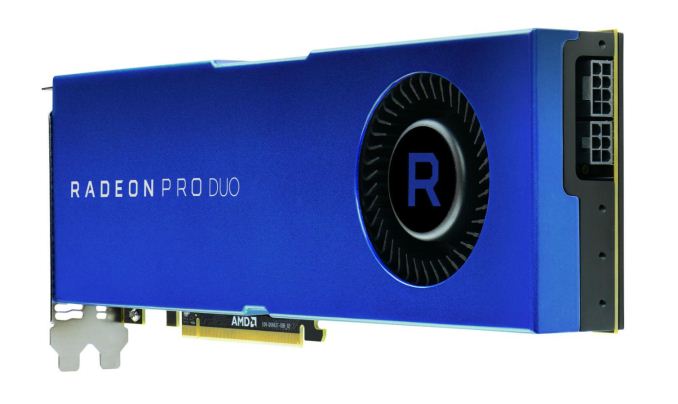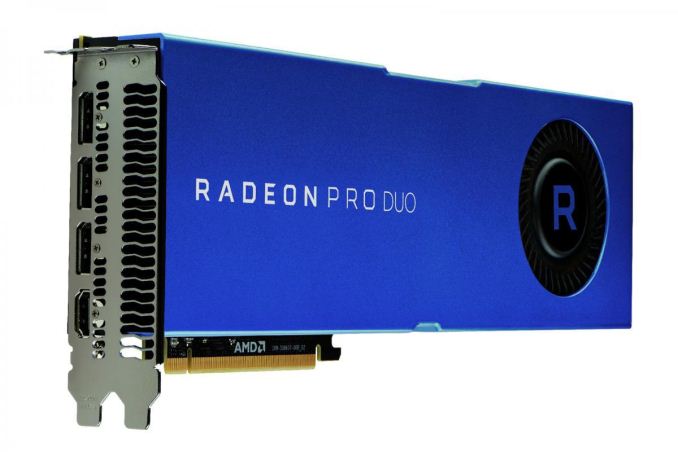AMD Announces Radeon Pro Duo (Polaris) - Double Polaris for Content Creation
by Ryan Smith on April 25, 2017 8:30 AM EST
Back in 2016 AMD launched the Radeon Pro Duo, an interesting take on a semi-pro workstation card. As a dual-GPU Fiji card wasn’t going to be viable for the consumer market, AMD instead focused their attention on developing such a card for the professional content creation market, where the lack of VRAM would be less of an issue and the second GPU more of an asset. The resulting card was best geared for a niche market, but none the less an important one for the company.
Until now, I hadn’t seen any real statistics on how the Radeon Pro Duo was doing in the market or if AMD would follow-up on it with newer products. Now at the 2017 NAB Show we have our answer, as AMD has announced their second Radeon Pro Duo. This time powered by a pair of the company’s Polaris 10 GPUs, the latest Radeon Pro Duo is aimed at roughly the same market as the original, but with all of the improvements that Polaris has brought the consumer market in the past year.
| AMD Workstation Card Specification Comparison | ||||||
| AMD Radeon Pro Duo (Polaris) | Radeon Pro WX 7100 | AMD Radeon Pro Duo (Fiji) | AMD Radeon R9 295X2 | |||
| Stream Processors | 2 x 2304 | 2304 | 2 x 4096 | 2 x 2816 | ||
| Texture Units | 2 x 144 | 144 | 2 x 256 | 2 x 176 | ||
| ROPs | 2 x 32 | 32 | 2 x 64 | 2 x 64 | ||
| Boost Clock | 1243MHz | 1243MHz | 1000MHz | 1018MHz | ||
| Memory Clock | 7Gbps GDDR5? | 7Gbps GDDR5 | 1Gbps HBM | 5Gbps GDDR5 | ||
| Memory Bus Width | 2 x 256-bit | 256-bit | 2 x 4096-bit | 2 x 512-bit | ||
| VRAM | 2 x 16GB | 8GB | 2 x 4GB | 2 x 4GB | ||
| Typical Board Power | 250W | 130W | 350W | 500W | ||
| GPU | Polaris 10 | Polaris 10 | Fiji | Hawaii | ||
| Architecture | Polaris | Polaris | GCN 1.2 | GCN 1.1 | ||
| Manufacturing Process | GloFo 14nm | GloFo 14nm | TSMC 28nm | TSMC 28nm | ||
| Launch Date | 05/2017 | 10/2016 | 04/2016 | 04/21/2014 | ||
| Launch Price | $999 | $649 | $1499 | $1499 | ||
Even though it goes after the same market as the last Pro Duo, the new Polaris-based Pro Duo is a much different card in a number of important ways, virtually all of which have to do with the differences in features and design between the previous Fiji GPU and the newer Polaris 10 GPU. Fiji was a high-end GPU that had to be reined in a bit to fit on a dual GPU card – and even then AMD needed a closed loop liquid cooler – whereas the Polaris 10 GPUs that go into the modern incarnation have a much more workable TDP from the start. Coupled with that, Polaris 10 doesn’t have the fixed VRAM capacity of Fiji, which means AMD can significantly increase the total VRAM. As a result, the new Pro Duo strikes a very different balance than the old card.
By the numbers then, the Polaris-based Radeon Pro Duo is actually slower than the older Fiji version. It has a clockspeed advantage, but this isn’t enough to overcome Fiji’s total stream processor advantage. All told, at peak rates the new Pro duo is rated for 11.45 TFLOPs of FP32, while the Fiji version was rated for 16.38 TFLOPs. In practice however I don’t expect that the gap is quite so large, as Fiji would need to throttle more often, and Polaris enjoys at least a small architectural advantage.
What the new Pro Duo loses in throughput it more than picks up in VRAM. With each Polaris 10 GPU sporting a 256-bit GDDR5 memory bus, AMD has outfit each GPU with 16GB of VRAM, quadrupling their VRAM capacity. AMD’s photos don’t show the bare PCB, but I believe it to be a safe bet that AMD is running 8Gb modules in clamshell mode, meaning the board is truly maxed out. AMD argued that the smaller VRAM capacity of the Fiji based card was not a major liability last year, and while there’s admittedly no reason not to fully equip a Polaris 10 card since the company is back to GDDR5, I do think it’s an important step in making the new card more flexible.
The other big change here is that the TBP has come down significantly, from 350W to 250W. Fiji was powerful, but it was also power-hungry, necessitating the original card’s closed loop liquid cooler. The Polaris Pro Duo, on the other hand, can get away with a simple blower. In fact this is the first time we’ve seen a blower-type dual GPU card from AMD in many years. And though an uncommon choice for a dual GPU card, it makes a great deal of sense given the card’s professional workstation market, as blowers are expected there, and the Radeon WX cards are already similarly equipped.
Under the hood – and particularly catering to the NAB crowd – the move to Polaris means that AMD can now support DisplayPort 1.4 and HDMI 2.0b a significant step up from DP 1.2 and HDMI 1.4b on the previous card. Besides natively supporting contemporary HDMI and HDR displays, this means that AMD can now also drive 8K monitors using a dual-cable setup. All told, the new card comes with 3x DP 1.4 ports and a single HDMI 2.0b port, and can drive all 4 ports at once.
With their new card AMD will be going after the same content creation niche as the old card, which means a mix of video production and VR. The latter in particular is still a growth market for AMD, and the card’s two GPUs means that developers can take advantage of AMD’s Affinity Multi-GPU technology with only a single card. Though to be sure, AMD is positioning and promoting this more like their Radeon WX professional cards, so like its predecessor, the new card will get AMD’s pro drivers and limited official support for the major CAD, CAM, and other engineering software packages.
Wrapping things up, the Polaris-based Radeon Pro Duo will be launching next month at $999. For the moment at least, this puts it at the head of AMD’s professional cards, at least until a WX Vega card finally shows up.
Source: AMD











36 Comments
View All Comments
Kevin G - Tuesday, April 25, 2017 - link
More than four displays hasn't been a problem on the OS side for years now and AMD has permitted up to 6 displays on their consumer drivers per card.nathanddrews - Tuesday, April 25, 2017 - link
AMD Eyefinity has supported six 4K screens on a single GPU since 2013 (2014?).ImSpartacus - Tuesday, April 25, 2017 - link
4K?I thought Eyefinity's original mantra was to use cheap 1080p monitors.
ddriver - Tuesday, April 25, 2017 - link
Thinking is not your strong point. Also, the hardware makes no distinction between cheap and expensive monitors.Kevin G - Tuesday, April 25, 2017 - link
The strategic goal of Eyefinity was to move gaming resolutions beyond 1080P as adding more displays. 4K hadn't arrived and 2560 x 1440 monitors were still expensive at the time. Eyefinity did push both AMD and nVidia to focus on higher resolution gaming, prices dropped and 4K isn't difficult to obtain.Eyefinity as a technology though hasn't changed and it is possible to utilize multiple 4K, 5K and even 8K to create a larger virtual surface. Three 8K displays would be pushing just shy of 100 million pixels. We'll probably be stuck with this as an effective upper limit as we're reaching the limits of what passive copper cabling can do even over short distances. Active cabling and/or transition to fiber will be necessary to really go beyond 8K
Roland00Address - Wednesday, April 26, 2017 - link
Sigh, when people talk about past 8k monitor for resolution I am reminded of this week's Silicon Valley Season Premiere where the first episode had a scene where the CEO is talking about a 10% image quality boost with same bandwidth and then the users can't tell the difference between the two. No matter he was talking fake tech specs of a 12 bit color vs 10 bit and no screen uses 12 bit, and very few screens use 10 bit correctly for while the screen may be able to display 10 bit often the OS and composite software was design for 8 bit and not the true version of 8 bit color but instead a smaller color space.Aka is it a real improvement, or just a perceived improvement for you say bigger tech specs and due to motivated reasoning I create a placebo type effect and I can truly see the difference, either through self delusion, or I can see a real difference for you force me to focus so intently on an insignificant factor that I am actually missing the full perception my eyes and brain can give me if I broaden my attention instead of hyperfocusing on nonsense information.
gerz1219 - Wednesday, April 26, 2017 - link
They're saying that a true VR experience with imperceptible pixels would require 8K per eye, and that means we'll eventually need some type of cable that can handle two simultaneous 8K streams.Yojimbo - Tuesday, April 25, 2017 - link
It's not encouraging for AMD that their professional cards are so cheap. This card is competing against what? The Quadro P5000? That card costs twice as much. AMD's software support must be sorely lacking.jabbadap - Tuesday, April 25, 2017 - link
Titan X/Xp, they are meant to content creation. Why would nvidia create mac driver for them anyway.Yojimbo - Tuesday, April 25, 2017 - link
Titan Xp isn't really for content creation. It doesn't come with professional software. It's for machine learning and gaming. I suppose if you can get away being without the professional drivers and software then you can use Titan Xp for that, but that just backs up my point. This Radeon Pro Duo card /is/ a professional card. It does come with professional software and support, doesn't it? So why is it priced to go up against cards that don't come with that software. I can only imagine it means that AMD's software sucks. For instance, perhaps the best professional applications use CUDA instead of OpenCL for their computations, or they are much faster using CUDA than using OpenCL.As far as the Mac driver, I think that's probably for the future. Apple probably has already decided to use NVIDIA cards again in some of their upcoming products.